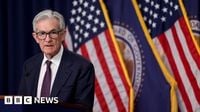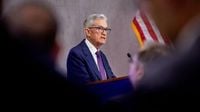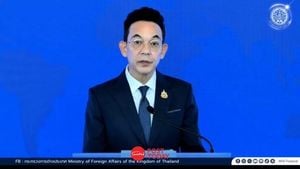On Wednesday, June 18, 2025, the Federal Reserve announced it would keep its benchmark interest rate steady, maintaining the federal funds rate in the range of 4.25% to 4.5%, a level it has held since December 2024. This marks the fourth consecutive meeting without a change, as policymakers adopt a cautious "wait-and-see" approach amid heightened economic uncertainty driven by tariffs and other global factors.
Federal Reserve Chair Jerome Powell emphasized that while the economy remains in a "solid position," the effects of President Donald Trump's import tariffs are expected to push inflation higher in the coming months. Powell noted, "Increases in tariffs this year are likely to push up prices and weigh on economic activity. This is something we know is coming, we just don’t know the size of it." He further explained that the inflationary impact could be temporary, but the Fed must remain vigilant to ensure longer-term inflation expectations stay anchored.
The Fed's latest economic projections reflect this cautious stance. Policymakers foresee inflation, as measured by the Personal Consumption Expenditures (PCE) Price Index, rising to 3% by the end of 2025, up from 2.1% in April. Core inflation, which excludes food and energy prices, is projected at 3.1%, also higher than previous forecasts. Meanwhile, economic growth is expected to slow significantly to 1.4% this year, down from 2.5% in 2024, and unemployment is projected to edge up to 4.5% from the current 4.2%.
Despite these headwinds, Powell highlighted that labor market conditions remain robust, with unemployment low and the economy growing at a "solid pace." He said, "The unemployment rate remains low, and labor market conditions remain solid. Inflation remains somewhat elevated," but added that the Fed is "well positioned to wait to learn more about the likely course of the economy before considering any adjustments to our policy stance."
Wall Street’s reaction to the announcement was mixed. Stocks initially rose during Powell's remarks but then dipped as investors digested the uncertainty surrounding tariffs and the Fed's cautious outlook. The Dow ended flat after swinging between gains and losses, while the S&P 500 and Nasdaq finished slightly up. Powell acknowledged the difficulty in forecasting the full impact of tariffs, stating, "We feel like we’re going to learn a great deal over the summer on tariffs. We haven’t been through a situation like this, and I think we have to be humble about our ability to forecast it, so that’s why we need to see some actual data."
The Fed’s "dot plot," a chart showing individual policymakers’ interest rate expectations, indicated that two rate cuts are still expected by the end of 2025, consistent with projections from March. However, the outlook for 2026 and 2027 was revised to anticipate fewer cuts, with only one cut each year instead of two, reflecting greater uncertainty. Notably, seven of the 19 Federal Open Market Committee (FOMC) participants now favor no rate cuts this year, up from four in March, signaling a more cautious approach.
Economists and analysts have interpreted Powell's remarks and the Fed's projections as a signal that the central bank will likely hold steady until at least September 2025, if not longer. George Pearkes, global macro strategist at Bespoke Investment Group, said, "Unless we see a really, really rapid deterioration in the labor market, we won’t see a cut until September, and maybe not even then." The CME FedWatch tool currently assigns a roughly 60% probability to a rate cut at the Fed's September 17 meeting, with the next policy meeting scheduled for July 29-30.
President Donald Trump, however, has been vocally critical of the Fed's reluctance to cut rates. On the day of the announcement, he called Powell "stupid" and accused him of being "political" for not lowering borrowing costs. Trump has argued that the Fed should reduce rates to stimulate the economy and ease the federal government's rising interest payments on its $36 trillion debt, which are expected to exceed $1.2 trillion this year. Yet economists warn that pushing the Fed to cut rates primarily to reduce government borrowing costs risks undermining its dual mandate to maintain price stability and maximum employment.
Internationally, the U.S. stance contrasts with moves by other central banks. The European Central Bank has cut rates eight times since June 2024, the Bank of Canada and the Bank of England have also reduced borrowing costs this year, while the Bank of Japan recently kept its key short-term rate steady at 0.5% after a recent increase. These divergent paths reflect differing economic conditions and policy priorities globally.
Domestically, signs of economic softening are emerging. Retail sales fell nearly 1% in May, and housing starts hit their lowest level in five years, partly due to elevated borrowing costs. Labor market data shows a slight uptick in layoffs and long-term unemployment. Yet Powell remains cautiously optimistic, noting that businesses and consumers appear to be adjusting to the new tariff environment with improving sentiment.
Looking ahead, the Fed will closely monitor inflation data and labor market trends, especially as the Trump administration’s 90-day pause on reciprocal tariffs ends on July 9, potentially leading to further tariff adjustments. Powell emphasized the importance of remaining forward-looking, stating, "Monetary policy has to be forward-looking – that is elementary... The economy seems to be in solid shape, so the labor market is not crying out for a rate cut."
As the summer unfolds, the Fed's ability to navigate this complex landscape—balancing tariff-driven inflation risks, slowing growth, and labor market dynamics—will be critical. For now, the central bank is holding steady, signaling patience amid uncertainty, while markets and policymakers alike await clearer economic signals.





